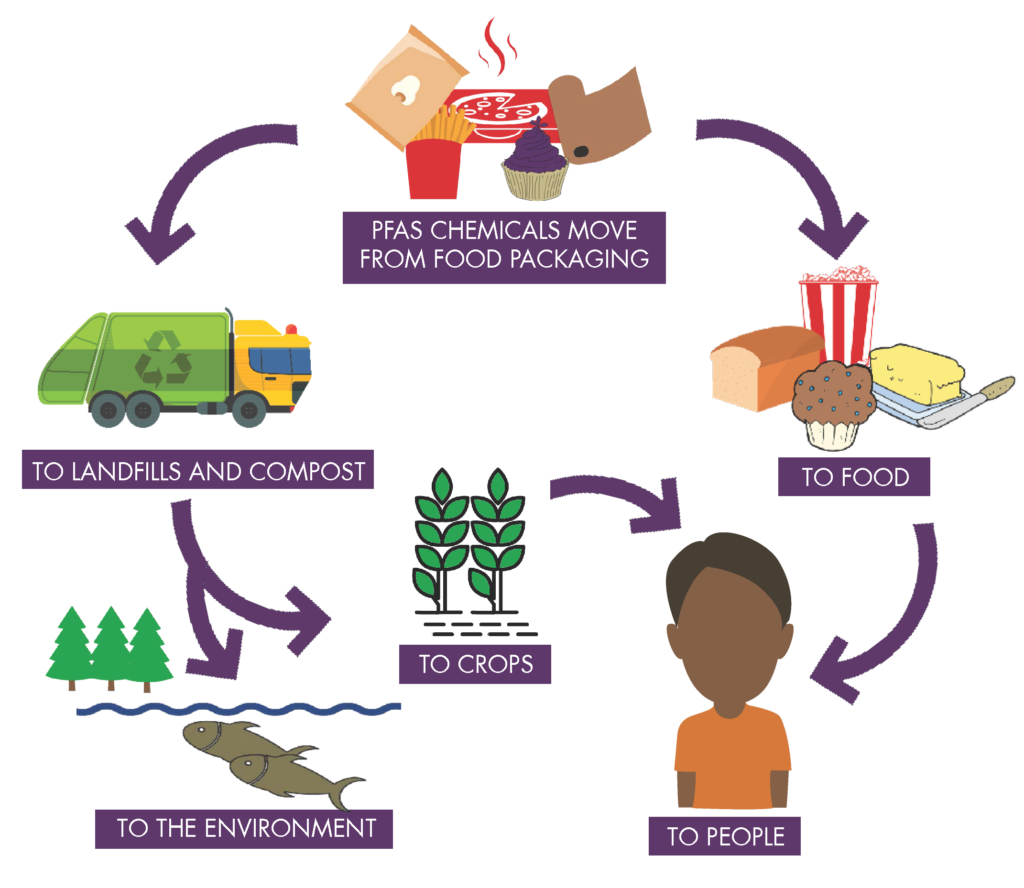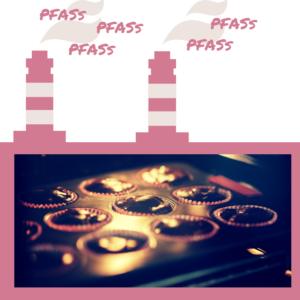If you’ve eaten microwave popcorn, a blueberry muffin, french fries, or toast with butter, it’s possible a dose of nonstick chemicals came with your meal.
Nonstick chemicals (often called PFAS chemicals) are used in food packaging to keep grease from soaking through the container or food from sticking to the package. Unfortunately, these harmful PFAS chemicals don’t all stick to the packaging. Instead, some move from the packaging, to our food and environment, raising serious health and environmental concerns.

Problematic PFAS Chemicals
Special chemical properties make PFAS chemicals extremely effective for repelling stains, water, and grease. They’re used in a wide variety of products like carpet, furniture, clothing, firefighting foam, and food packaging. But their effectiveness is also what makes them problematic.
PFAS chemicals don’t break down easily in our bodies or in the environment, prompting scientists to call them “virtually indestructible.” Some PFAS chemicals can stay in our bodies for as long as eight years or more.
The chemicals are linked to kidney and testicular cancer, hormone disruption, liver toxicity, harm to the immune system, and reduced birth weight. This combination of persistence and toxicity makes exposure to PFAS chemicals especially concerning. Unfortunately, human exposures are occurring on a daily basis.
A study of over 600 American kids found that every single child tested had PFAS chemicals in their body. It’s showing up in breast milk too. Recent testing of breast milk from 264 women, found that 67%-82% of the women’s breast milk contained newer PFAS chemicals, which were then likely passed on to their newborns.
PFAS Chemicals in Food Packaging Get into Our Food

PFAS-treated food packaging plays a role in these exposures. Nonstick chemicals can move from the packaging, to the food, and then into our bodies with each bite. Muffin cups, sandwich wrappers, butter wrappers, and microwave popcorn bags have all been found to leach nonstick chemicals into food.
The amount of nonstick chemicals that move to the food appears to increase when the food and the PFAS-treated material are heated. For example, bread heated for 10 minutes in a coated wrapper was found to have higher levels of PFAS chemicals than before heating, as has microwave popcorn popped in a PFAS-coated bag. Surprisingly, in some cases the PFAS-treated material acts like a “PFAS factory,” producing additional PFAS chemicals as the nonstick coatings break down.
But it’s not just heated packaging. PFASs have been found to migrate even in cold storage. One PFAS compound in butter wrapped in a coated wrapper increased 8-fold after being stored for 45 days.
The Connection Between PFAS in Food Packaging and the Environment
While fish and birds aren’t eating food packaged in materials coated with nonstick chemicals, food packaging is still a source of PFAS to the environment. When packaging containing nonstick chemicals is discarded into compost or landfilled, the chemicals pollute water, soil, and wildlife.
Researchers are detecting nonstick chemicals in compost, landfill leachate, and biosolids, which is organic material created from sewage. Because these chemicals don’t break down easily, they move through the environment for many years.
In Washington state, PFAS chemicals have been found in salmon, freshwater fish, osprey eggs, and in surface waters of Puget Sound, freshwater lakes and rivers. There is cause for concern. For example, laboratory studies have linked PFAS chemicals to hormone disruption in Atlantic salmon, to liver cancer and hormone disruption in rainbow trout, and to liver toxicity and abnormal sexual development in tadpoles. PFAS chemicals have also been linked to decreased hatching success in tree swallows and decreased reproductive success of bumble bees (an important pollinator), as well as immune, hematopoietic, kidney, and liver function effects in South Carolina bottlenose dolphin.
Scientists have also shown that nonstick chemicals in the environment are taken up by crops, creating another route of exposure in the cycle of pollution.
Are We Stuck with Nonstick PFAS Chemicals in Food Packaging?
The good news is that manufacturers are making alternatives and food companies are beginning to opt for non-PFAS alternatives. In recent testing, less than half of the packaging tested positive for PFAS chemicals.
Food packaging offers a commonsense and easy place to start to eliminate a source of chemicals that have become a serious public and environmental problem.
There are many sources of nonstick chemicals to our bodies and the environment. For example, firefighting foam is the most likely culprit for contaminated drinking water in several communities, and stain-resistant coatings on products like carpets and clothing also contribute to our overall dose. PFAS chemicals are used in so many ways, it will take a comprehensive plan to limit their use and to clean up existing contamination.
But the evidence is clear on nonstick chemicals in food packaging: the chemicals aren’t good for our health, don’t stay where they are supposed to, and move to where we don’t want them – our food and environment.
UPDATE: Governor Inslee signed the Healthy Food Packaging Act (HB 2658) into law March 21, 2018.




